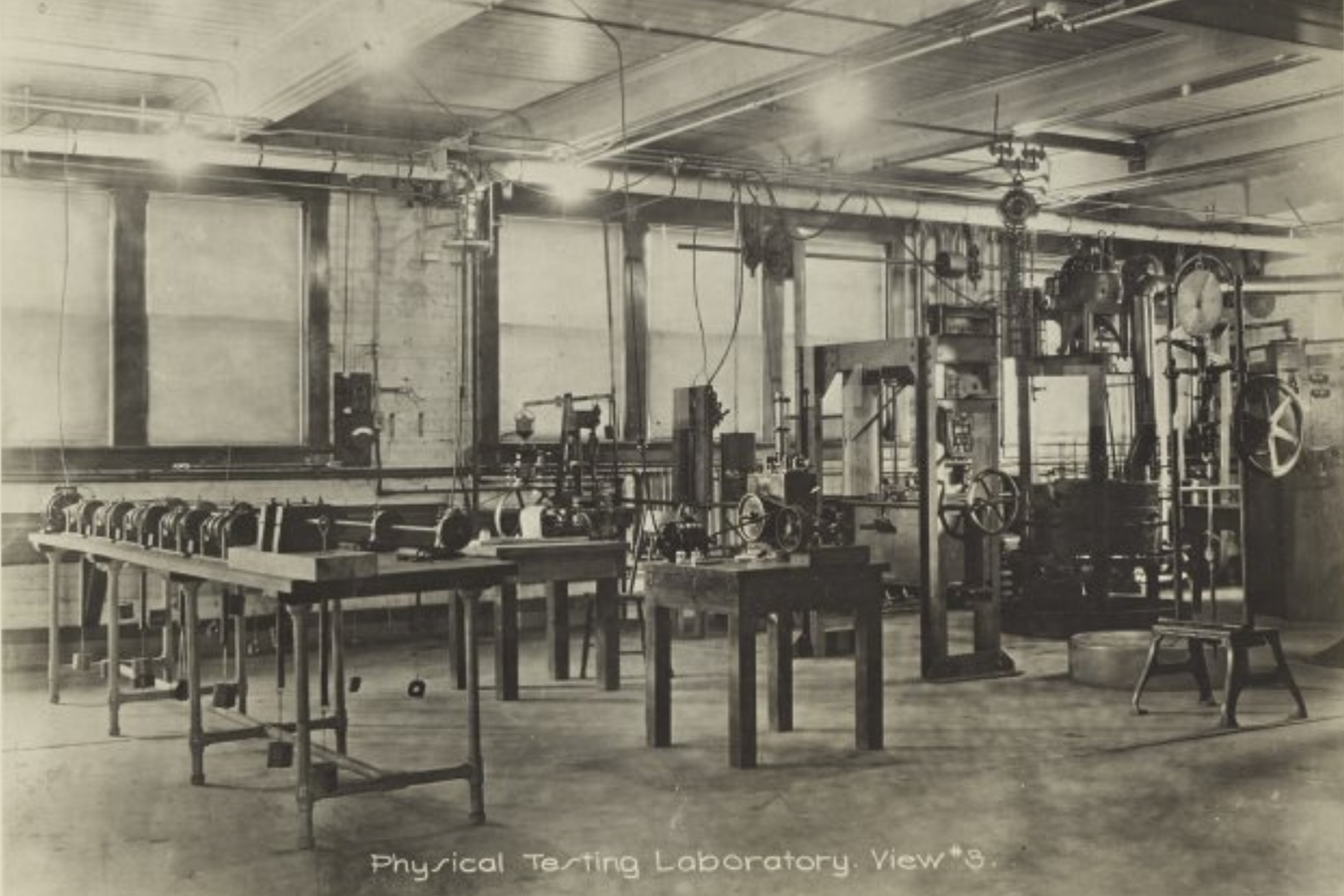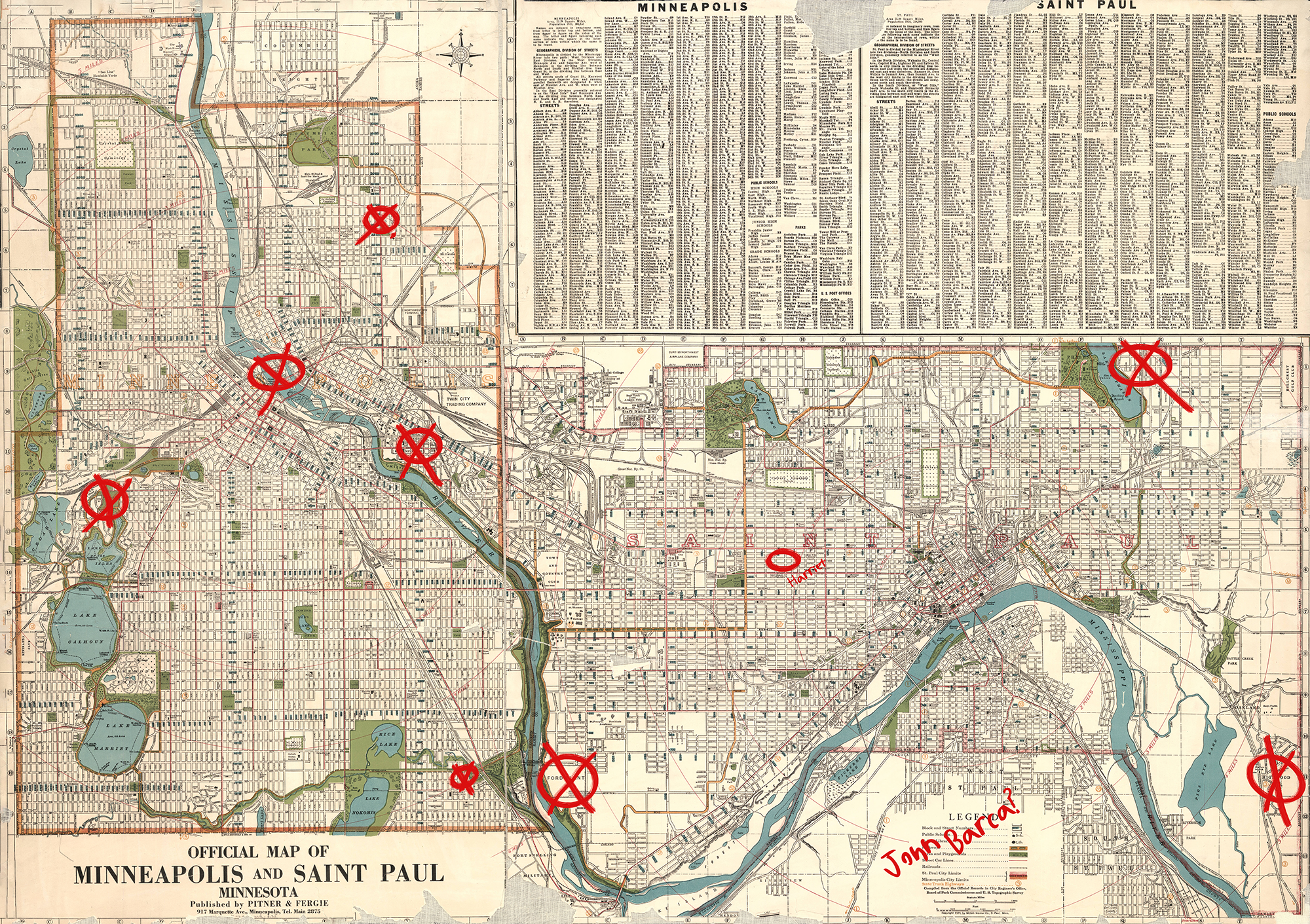
NODE 7: HARRIS CHEMICAL PLANT
(4121 Minnehaha Ave., Minneapolis, MN)
- Located along Minnehaha Avenue, which runs between downtown Minneapolis and Minnehaha Falls.
- A Milwaukee Road rail line runs behind the chemical plant, servicing other factories and grain silos that run up and down the western side of Minnehaha Avenue.
- A rail spur runs into the Harris loading dock, it’s not unusual for 1-3 tanker cars to be parked there (loading or unloading chemicals).
BACKGROUND
- Founded by Ezra Harris in 1895.
- Ezra Harris died in 1905 and the company was inherited by his son Clarence.
- Clarence died in 1923 without heir and the company was acquired by John Barca. (Clarence was actually poisoned by Tanit cultists specifically so that they could acquire the company.)
- Harris Chemicals has a contract with the federal government to denature alcohol: Although banned by Prohibition, alcohol still has a wide variety of necessary uses in industry. When it became clear that this industrial alcohol was being used to create illegal liquor, the government began denaturing the alcohol — adulterating the alcohol with foul-tasting additives that wouldn’t affect its industrial uses, but made it unpalatable for drinking.
- Under Barca’s direction, some of the denatured alcohol is also adulterated with Tanit parasites. This alcohol is then dropped off at an otherwise abandoned warehouse a few blocks south on Minnehaha Avenue, where Oleg Andersson picks it up and takes it to Node 6: Davis Farm to be renatured and turned into Minnesota 13.
- The secret section of the denaturing plant where the Tanit parasites are added to the alcohol is also being used as a convenient holding facility for kidnapped kids before they are taken to Node 8: Minneapolis Federal Reserve.
SURVEILLANCE
Workers: The plant employs nearly fifty people. It operates twenty-four hours a day in three shifts, although the night shift is a skeleton crew.
Security: There are four security guards on the day shifts (one at the front desk, one at the loading docks, and two on patrol). At night this is increased to six security guards. (This seems like an unusual amount of security for a business like this.)
Loading Dock: There are usually 1-3 tanker cars on the Harris rail spur, which are filled or emptied with special pipes and hoses before being picked up. Trucks arrive throughout the day, loading and unloading barrels.
Secure Denaturing Facility: External surveillance will note a special freight elevator on the loading dock that requires special keys to access. (This freight elevator leads to the denaturing facility.) PCs who gain access to the plant interior (getting hired, posing as inspectors, etc.) will be able to identify the location and public function (denaturing alcohol) of the secure facility.
John Barca: Barca will intermittently stop by the facility. He’ll visit the management offices and then go into the secure denaturing facility (on his way to the Tanit infusion area). Streetwise or Bureaucracy pegs him as out of place (his suit and shoes several tax brackets above anyone else working here). He can be followed back to Node 8: Minneapolis Federal Reserve.
Company-Owned Truck: Harris Chemical Plant has a single company-owned truck, which can be noticed as distinct from the other trucks coming and going from the loading dock. Following this truck will reveal a handful of local deliveries, but also notably:
- Being loaded with barrels of denatured alcohol that’s dropped at an abandoned warehouse a few blocks north. (Oleg Andersson then picks these barrels and takes them to Node 6: Davis Farm.)
- Transporting kidnapped kids (see below).
- Leaving empty to pick up tophet serum from Node 8: Minneapolis Federal Reserve and bringing it back here.
Moving Alex Griffin: During the night shift on Sunday, November 15th, Alex Griffin is moved to Node 8: Minneapolis Federal Reserve by four Tanit cultists in the company-owned truck. (He’s brought down the secure elevator and loaded into the company truck.)
QUESTIONING WORKERS
Drivers: The Harris drivers can give details about their normal delivery schedule and the secure freight elevator used for processing denatured alcohol.
- They also intermittently pick up crates from Node 8: Minneapolis Federal Reserve, which are sent up the secure freight elevator to the denaturing facility.
- Any Interpersonal 1 / Credit Rating 1: The Harris drivers will reveal that they intermittently drop denatured alcohol at an abandoned warehouse a couple blocks north of the chemical plant. They don’t know, but they suspect what happens to it after they drop it off.
Other Workers: Any Harris worker can tell the PCs about normal plant operations, layout, and the secure denaturing facility.
ENTRANCES / GETTING IN
Front Entrance: On the corner of the building. Leads to the Front Office.
Loading Dock:
- Front Office: A door leads from the Loading Dock to the Front Office.
- Factory Floor: Large doors lead from the Loading Dock to the Factory Floor.
- Freight Elevator: Goes up to the Testing Labs on the 3rd Floor.
- Secure Elevator: Goes up to the Denaturing Facility on the 4th Floor.
Windows: 1st Floor windows are barred (except in the Front Office). Windows on the higher storeys are unbarred (except for the 5th Floor, which are heavily secured and cannot be opened).
INTERIOR

1st FLOOR
1st FLOOR – LOADING DOCK
- Trucks can drive into the rear loading yard from the street; there’s an entrance gate and an exit gate.
- The rail spur leads directly across Harris Chemical’s yard and into the loading area.
- There are two freight elevators — one leads to testing labs on the 3rd Floor; a secure freight elevator leads to the Secure Denaturing Facility on the 4th Floor.
- Large loading doors lead to the Factory Floor.

FRONT OFFICE
- Located on the corner of the building.
- Staff here manages customers and processes shipping documents brought here from the loading docks.
- Stairs lead up to the Management Offices on the 2nd Floor; and down to the Basement.
- Bureaucracy: There’s plenty of evidence to be found here of John Barca’s ownership of the company, although he seems to take little interest in the day-to-day management, except for the denaturing contracts.
FACTORY FLOOR
On the far side of the loading docks from the Front Office.
- Various vats, pressure vessels, and the like.
- The ceiling is two storeys high with windows primarily on the upper level.
- Stairs lead down into the Basement; and up to the Testing Labs.
- The Management Offices overlook the factory floor; there’s a balcony and also large glass windows. A staircase leads from the offices down to the factory floor.

BASEMENT
- Non-volatile storage.
- PCs can waste a lot of time down here, but there’s little of interest.
- File Cabinets: Digging through these dusty records with Bureaucracy will reveal the factory’s history of ownership (including John Barca’s current ownership). It will also reveal that the 4th Floor was heavily revamped to accommodate the federal denaturing contracts, and further construction work was done up there following Barca’s acquisition of the company.
2nd FLOOR
MANAGEMENT OFFICES
- These offices overlook the Factory Floor. (There’s a balcony and a glass wall. Stairs lead down from the balcony to the Factory Floor.)
- In the corner of the building directly above the main entrance, there’s a spiral staircase leading up to John Barca’s office (which is on the top floor of a tower). Bureaucracy in Barca’s office both identifies him as the owner of Harris Chemical and reveals that chemical shipments are being made from Node 8: Minneapolis Federal Reserve which he’s personally overseeing (which doesn’t make a lot of sense, although they’re tied to the federal denaturing contracts).
3rd FLOOR
TESTING LABS
- Chemistry reveals that these labs are conducting perfectly mundane testing and development work; exactly what you’d expect from an industrial chemical plant.
- Well-secured doors limit access to the 4th Floor.

4th FLOOR
SECURE DENATURING FACILITY
- Can be accessed via well-secured stairwells from the 3rd Floor or via the secure freight elevator from the Loading Docks.
- Evidence Collection / Bureaucracy: John Barca has left detailed instructions on the specific quantity of denatured alcohol which, instead of being directly shipped out, should be redirected to the 5th Floor. (These instructions explicitly identify John Barca.)
- Entrance to Tanit Infusing Facility: The entrance to the secure facility on the 5th Floor is hidden, requiring a 1-point spend to find. (Any leveraged clued pertaining to the secure facility — records of the facility, noticing the 5th Floor windows on the outside of the building, etc. — removes the requirement for the 1-point spend.)
5th FLOOR
TANIT INFUSING FACILITY
- In this special chemistry lab, Tanit parasites — stored in glass bottles containing purplish liquid — are carefully infused into the denatured alcohol.
- Chemistry: Procedural notes here reveal that the Harris Chemical denaturing process has been carefully designed to prepare the alcohol for infusion with the “tophet serum.” (Infusing raw alcohol would apparently “sterilize” the serum.)
- Crates: Labels on empty and half-empty crates indicate that the “tophet serum” is shipped here from Node 8: Minneapolis Federal Reserve.
- Bureaucracy 1: The markings indicate that the crates were stored in the vault at the Federal Reserve Building.

HOLDING CELL
- Alex Griffin is held in a small, heavily soundproofed cell on the far side of the Tanit Infusing Facility.
- Alex Griffin: Alex was kidnapped from Node 4: Harriet Tubman’s Asylum for Colored Orphans and brought here several days ago. He doesn’t really understand what’s happening, he’s very scared, but he’s just barely managing to keep it together. Any show of human kindness or a suggestion that the PCs are going to take him somewhere safe triggers an emotional breakdown (Reassurance can help pull him back together). Alex notably overheard someone say that he was going to be “taken to the Fed,” although he doesn’t know what that means.
NPCs AT HARRIS CHEMICAL
HARRIS CHEMICAL SECURITY: Athletics 5, Mechanical Repair 4, Scuffling 6, Fleeing 4, Weapons 5, Health 8
Alertness Modifier: +1 (Careful Eye)
Stealth Modifier: -1 (Uniforms stand out)
Weapons: .38 revolver (0), Billie Club (-1), Fists (-2)
TANIT CULTISTS: Athletics 5, Firearms 4, Scuffling 6, Weapons 5, Health 8
Alertness Modifier: +1 (three eyes are better than two)
Stealth Modifier: 0
Weapons: dagger (0), fists (-2), small caliber pistols (-1)
Stability Loss: +0, if seeing the eye













